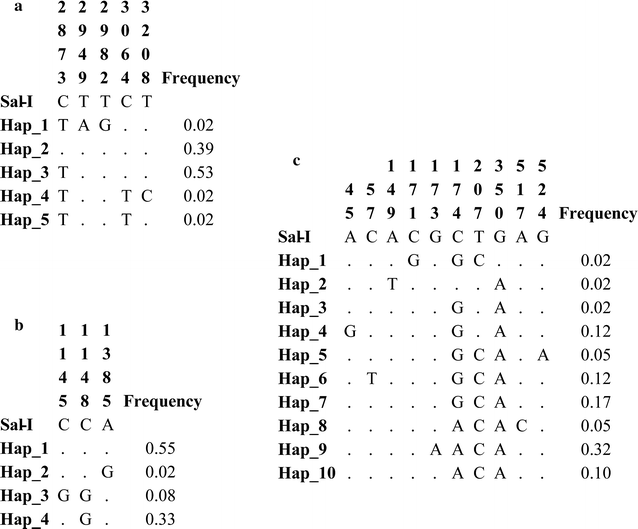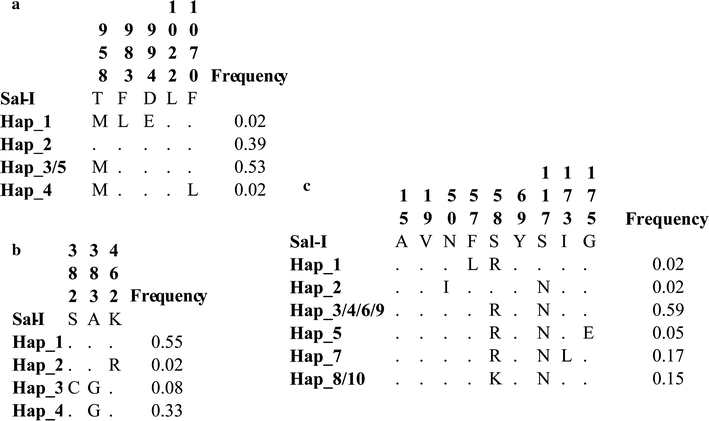Simultaneous detection of Plasmodium vivax dhfr, dhps, mdr1 and crt-o resistance-associated mutations in the Colombian Amazonian region
- PMID: 29580244
- PMCID: PMC5870912
- DOI: 10.1186/s12936-018-2286-5
Simultaneous detection of Plasmodium vivax dhfr, dhps, mdr1 and crt-o resistance-associated mutations in the Colombian Amazonian region
Abstract
Background: Malaria continues being a public health problem worldwide. Plasmodium vivax is the species causing the largest number of cases of malaria in Asia and South America. Due to the lack of a completely effective anti-malarial vaccine, controlling this disease has been based on transmission vector management, rapid diagnosis and suitable treatment. However, parasite resistance to anti-malarial drugs has become a major yet-to-be-overcome challenge. This study was thus aimed at determining pvmdr1, pvdhfr, pvdhps and pvcrt-o gene mutations and haplotypes from field samples obtained from an endemic area in the Colombian Amazonian region.
Methods: Fifty samples of parasite DNA infected by a single P. vivax strain from symptomatic patients from the Amazonas department in Colombia were analysed by PCR and the pvdhfr, pvdhps, pvmdr1 and pvcrt-o genes were sequenced. Diversity estimators were calculated from the sequences and the haplotypes circulating in the Colombian Amazonian region were obtained.
Conclusion: pvdhfr, pvdhps, pvmdr1 and pvcrt-o genes in the Colombian Amazonian region are characterized by low genetic diversity. Some resistance-associated mutations were found circulating in this population. New variants are also being reported. A selective sweep signal was located in pvdhfr and pvmdr1 genes, suggesting that these mutations (or some of them) could be providing an adaptive advantage.
Keywords: Amazonian region; Antimalarial drug resistance; Colombia; Malaria; Plasmodium vivax; pvdhfr; pvdhps; pvmdr1 and pvcrt-o.
Figures


Similar articles
-
Molecular surveillance for drug resistance markers in Plasmodium vivax isolates from symptomatic and asymptomatic infections at the China-Myanmar border.Malar J. 2020 Aug 5;19(1):281. doi: 10.1186/s12936-020-03354-x. Malar J. 2020. PMID: 32758218 Free PMC article.
-
Distribution of Mutations Associated with Antifolate and Chloroquine Resistance among Imported Plasmodium vivax in the State of Qatar.Am J Trop Med Hyg. 2017 Dec;97(6):1797-1803. doi: 10.4269/ajtmh.17-0436. Epub 2017 Sep 28. Am J Trop Med Hyg. 2017. PMID: 29016333 Free PMC article.
-
Assessment of drug resistance associated genetic diversity in Mauritanian isolates of Plasmodium vivax reveals limited polymorphism.Malar J. 2018 Nov 8;17(1):416. doi: 10.1186/s12936-018-2548-2. Malar J. 2018. PMID: 30409138 Free PMC article.
-
Assessment of copy number variation in genes related to drug resistance in Plasmodium vivax and Plasmodium falciparum isolates from the Brazilian Amazon and a systematic review of the literature.Malar J. 2017 Apr 19;16(1):152. doi: 10.1186/s12936-017-1806-z. Malar J. 2017. PMID: 28420389 Free PMC article. Review.
-
A review of malaria molecular markers for drug resistance in Plasmodium falciparum and Plasmodium vivax in China.Front Cell Infect Microbiol. 2023 May 9;13:1167220. doi: 10.3389/fcimb.2023.1167220. eCollection 2023. Front Cell Infect Microbiol. 2023. PMID: 37228664 Free PMC article. Review.
Cited by
-
Are pvcrt-o and pvmdr1 Gene Mutations Associated with Plasmodium vivax Chloroquine-Resistant Parasites?Biomedicines. 2024 Jan 9;12(1):141. doi: 10.3390/biomedicines12010141. Biomedicines. 2024. PMID: 38255246 Free PMC article.
-
Surveillance of drug resistance molecular markers in Plasmodium vivax before and after introduction of dihydroartemisinin and piperaquine in Thailand: 2009-2019.Parasitol Res. 2023 Dec;122(12):2871-2883. doi: 10.1007/s00436-023-07977-2. Epub 2023 Sep 19. Parasitol Res. 2023. PMID: 37725258
-
Potential of nanoformulations in malaria treatment.Front Pharmacol. 2022 Oct 26;13:999300. doi: 10.3389/fphar.2022.999300. eCollection 2022. Front Pharmacol. 2022. PMID: 36386185 Free PMC article. Review.
-
Novel highly-multiplexed AmpliSeq targeted assay for Plasmodium vivax genetic surveillance use cases at multiple geographical scales.Front Cell Infect Microbiol. 2022 Aug 11;12:953187. doi: 10.3389/fcimb.2022.953187. eCollection 2022. Front Cell Infect Microbiol. 2022. PMID: 36034708 Free PMC article.
-
Population genomics and evidence of clonal replacement of Plasmodium falciparum in the Peruvian Amazon.Sci Rep. 2021 Oct 27;11(1):21212. doi: 10.1038/s41598-021-00806-5. Sci Rep. 2021. PMID: 34707204 Free PMC article.
References
-
- WHO . World malaria report 2016. Geneva: World Health Organization; 2016.
-
- Santa Maria-Salamanca M, Londoño-Soto B, Urquijo-Velasquez LE, Díaz-Gómez A, Padilla-Rodríguez JC. Gestión para la vigilancia entomológica y control de la transmisión de malaria. Colombia: Ministerio de la protección social; 2010. pp. 2–130.
-
- PAHO . Guia de atención clínica de malaria 2010 (Documento actualizado de versión convenio 256/09) República de Colombia: Ministerio de la protección social; 2010. p. 2010.
MeSH terms
Substances
Grants and funding
LinkOut - more resources
Full Text Sources
Other Literature Sources
Research Materials

